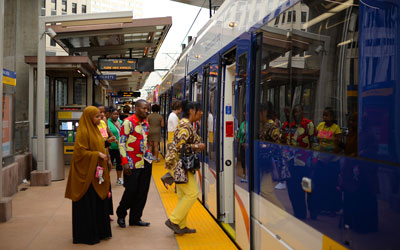About the Research
Disadvantaged urban workers often find themselves in a double bind. They may be qualified for many entry-level jobs, but have no way of reaching suburban employment centers; they may also be easily able to reach many jobs nearby, but lack the qualifications for them. These two statements describe the interconnected problems of spatial mismatch and skills mismatch.
This project studied the current state of spatial and skills mismatch in the Twin Cities region, as well as coordination between transit planning and workforce development and opportunities to improve that coordination.
Key findings include:

- Access to job vacancies via transit varies greatly by industry and location within the region. While transit access is generally good in the inner city, some areas of intense disadvantage—such as North Minneapolis, Brooklyn Park, and Midway St. Paul—have relatively poor access to suburban job centers.
- Important “sweet spots” exist for locally targeted workforce development efforts in the Twin Cities. In high-demand sectors, there are a significant number of occupations in which most job vacancies do not require postsecondary education and offer a livable median hourly wage. In addition, a number of occupations recur across sectors, presenting opportunities for combined training programs.
- There is a strong perception of need for more coordination of transit and workforce development. This appears to be particularly true in suburban areas where transit has traditionally had less relevance to workforce development than in urban areas with at least high levels of traditional bus service.
The report concludes with policy recommendations centered on finding “sweet spots” for coordinated transit planning and workforce development and on creating a future transit system to serve the needs of disadvantaged workers.
Sponsors
Produced at the Hubert H. Humphrey School of Public Affairs, University of Minnesota, with support from Hennepin County, Minnesota; the Jay and Rose Phillips Family Foundation; and the McKnight Foundation.
More Information
For the Media
Media Contact
- Michael McCarthy, Editor/Media Relations, 612-624-3645, mpmccarthy@umn.edu
News Release
- Transit and training crucial to connecting unemployed with jobs
University of Minnesota News, June 28, 2016
Media stories
- How the Twin Cities' Transit Expansion Will Improve Access to Jobs
CityLab, July 13, 2016 - Study: Big disconnect between jobs and transit
StarTribune, July 12, 2016 - Subsidized Uber rides for workers could be worth the cost, University of Minnesota study finds
Minneapolis/St. Paul Business Journal, June 30, 2016